Fat isn't all that bad! Not if you're talking about omega-3 for dogs, anyway. Like people, dogs need a bit of fat to sustain themselves. We're not talking about just any kind of fat, though. We're talking about omega-3, 6, and 9 fatty acids — the "good" kind of fat. Omega fats are necessary for heart, skin, brain, and metabolic health.
If you didn't know there were different types of fat, no problem! This article will break down all the juicy details (no pun intended) of omega fatty acids: what they are, where they come from, and how they benefit your dog.
What are Omega Fatty Acids?
Omega fatty acids 3, 6, and 9 are unsaturated fats. Unsaturated fats have loose molecular bonds that can easily be broken. Since these fats are more soluble, they don't raise cholesterol levels as much as trans or saturated fats. Some experts speculate that omega fatty acids may trigger hormones that fight swelling and regulate blood flow. That's why you might hear omega fats referred to as "healthy" or "good" types of fat.
Omega 3 fish oil dosage chart dog are three different omega acids: 3, 6, and 9. These may sound complex, but the acid number (3, 6, or 9) simply refers to the position of the carbon-carbon double bond in the molecular chain. You don't need to worry about the chemistry, though! The key takeaway is that each acid behaves differently in your dog's body.

What Does Omega 3 Do for Dogs?
Omega-3 fatty acids are essential fatty acids, meaning your dog's body cannot produce them on its own. The only way for your dog to get omega-3 fatty acids is through its diet. These fats counter swelling, support brain function, and promote the health of your dog's skin and coat. Different forms of omega-3 can be obtained from either plant or animal sources. EPA (eicosapentaenoic acid) and DHA (docosahexaenoic acid) are marine forms of omega-3 found in fatty fish like salmon, mackerel, herring, and sardines.
ALA (alpha-linolenic acid) is a plant form of omega-3 that naturally occurs in flaxseeds, canola oil, soybeans, and pumpkin seeds. It's important to know that ALA can only be used as energy once it's converted to EPA and DHA by your dog's body, which is a long process. Therefore, your dog's diet must include plenty of EPA and DHA to help ALA energize your pooch.
The soothing properties of omega-3 fatty acids are especially helpful for dogs with uncomfortable joints. Since omega-3 acids may soothe the skin, they can also help alleviate dandruff, dry skin, and other cutaneous conditions.
What Does Omega 6 Do for Dogs?
Omega-6 fatty acids are also essential for a healthy dog's diet. Omega-6 acids have a similar structure to omega-3 fatty acids. Omega-6 fatty acids are critical for cell structure, immune function, reproductive purposes, and skin and coat health. Natural sources of omega-6 fatty acids include corn, soybeans, poultry, eggs, nuts, and vegetable oils like sunflower and safflower oil. Since processed dog food contains many of these ingredients, it's often very high in omega-6 acids.
Many dogs need extra omega-3 fatty acids to balance the amount of omega-6 acids they consume in their regular diet. These acids work in tandem with omega-3 fatty acids to support your dog's system, so your furry friend must have adequate levels of both. Omega-6 acids help build cell membranes in your dog's body. They also play a role in gene functioning, so optimal levels of omega-6 are necessary for healthy reproduction. Like omega-3 acids, omega-6 fatty acids support your dog's immune system and skin health.
What Does Omega 9 Do for Dogs?
Unlike omega-3 and 6, omega 9 for dogs are non-essential. However, this doesn't mean that your dog doesn't need them — they absolutely do! It means that your dog already produces omega-9 acids in its body. Still, some extra omega-9 may boost your dog's immune function and lower cholesterol.

How Much Omega 3-6-9 Should My Dog Have?
The ideal ratio of omega-6 to omega-3 fatty acids is 4:1. There is no standard ratio for omega-9 fatty acids because they're non-essential. Most commercial diets are far out of balance, with omega 6-3 ratios ranging from 10:1 to 20:1. A diet that's too high in omega-6 acids can lead to inflammation, skin issues, joint problems, and obesity.
Since the average canine diet is high in omega-6 acids, your dog likely needs more omega-3. However, it's also possible to give your dog too much omega-3. The amount of omega-3 acid you give your dog will depend on its weight and the product you choose to give it.
Keep in mind that there are two types of omega-3 fatty acid that your dog needs: EPA and DHA. A general rule of thumb is to give your dog 300mg of combined EPA and DHA per 30 lbs of body weight. Most products that include omega-3 will contain both EPA and DHA, but be sure to check the label or ask the manufacturer to confirm!
How to Give Omega Fatty Acids to Dogs
Giving your dog omega fatty acids is a lot simpler than you may think. Several products can provide your dog with a vital omega acid boost — just make sure to read the dosing directions carefully. Some dog treats are also rich sources of omega fatty acids. We've collected some of the most effective, natural options for getting your dog some omega 3 dog chews. First, let's look at fish oil.
Omega-3 Fish Oil for Dogs
Fish oil is one of the most popular omega-3 sources for dogs. Some fish are naturally high in omega-3 fatty acids. Commercial fish oil is extracted from fish tissue through a press or centrifuge and then purified. This process creates a liquid solution with a high concentration of omega-3 fatty acids.
The most common fish oil for dogs comes from salmon, but oil from anchovies, herring, mackerel, and sardines are also common. Regardless of the source, all fish oil contains high levels of the omega-3 acids EPA and DHA. Fish oil typically doesn't have significant amounts of omega-6 or 9 acids unless they're added to the formula.
The best fish oil products come from a single fish source. A formula containing a blend of oils is still beneficial, but single-source products provide the same value and are less likely to trigger allergic reactions.
Hemp Seed Oil for Dogs
Hemp seed oil is another great option if you're looking to get some extra omega acids in your dog's diet. Derived from hemp seeds, this nutritious oil has all the omega fatty acids: 3, 6, and 9. Although it hails from the plant, hemp seed oil doesn't contain any THC. This means your dog won't get intoxicated or "high."
Hemp seed oil is made by pressing hemp seeds with a special machine that extracts the oil from the seeds. The resulting solution is a green, translucent liquid with a diverse nutrient profile. Some manufacturers refine the product even further until it's colorless and uses it in a range of cosmetics (mostly soaps and shampoos).
There is more to hemp seed oil vs fish oil than just its nutritional value. You can also apply the solution topically to moisturize the skin and soothe irritation. Hempseed oil also has three times more omega-3 than 6, so you won't have to worry about overloading your dog with omega-6 fatty acid.
Omega 3-6-9 Dog Treats
Best omega 3 fatty acids dog treats can also provide these fatty acids to your dog's diet — if you choose the right kind. HolistaPet's CBD Dog Treats are the ideal option for giving your pooch a tasty and healthy snack. Our treats include hemp seed oil, which provides all the omega fatty acids your dog needs to thrive.
We always keep your pet's health in mind when we're baking our treats. This is why we never include gluten, GMO, artificial dyes, preservatives, or non-organic ingredients in our biscuits. Plus, each treat contains CBD oil to relax your canine friend.
CBD Oil for Dogs
Our full-spectrum CBD oil provides incredible benefits to your furry friend. We extract CBD oil from hemp plants using natural CO2 instead. Other companies use solvents, but these can be dangerous to handle and may leave behind toxic residue. Our oil contains high-grade cannabidiol (CBD), which is a non-intoxicating compound that supports your dog's endocannabinoid system (ECS). The ECS is a major player in cell communication and internal regulation, so keeping it in shape is vital for your dog's health. Unlike THC, CBD won't get your dog high.
Instead, it works in the background to keep your dog's ECS running up to speed. When the ECS receives a little extra support, your dog can experience several benefits. CBD has been known to calm hyperactive dogs and reduce skittishness and aggressive tendencies in frightened dogs. If your dog has trouble getting around, CBD can soothe their aching limbs and may help mobility.
Curious about cats? Be sure to check out our article Omega-3 for Cats to find out if your feline friend can benefit from omega fatty acids!

Final Thoughts
It's about time you start thinking about getting your dog some fat! Omega fatty acids are vital to your dog's health. A stronger immune system, supple joints, improved mood, and shiny coat are within sight — you just need to get that omega ratio right. Whether you go with fish oil, hemp seed oil, or our very own CBD dog treats is all up to you!

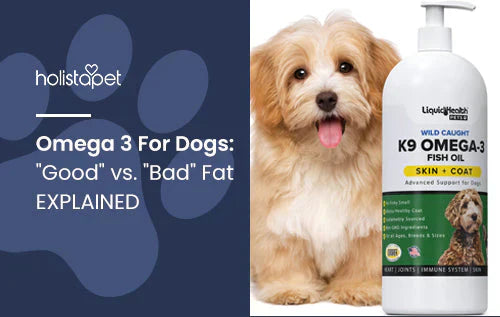
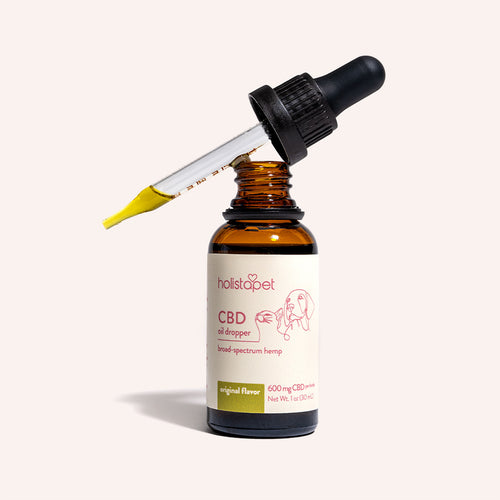 CBD Oil for Dogs - Fast Acting
CBD Oil for Dogs - Fast Acting
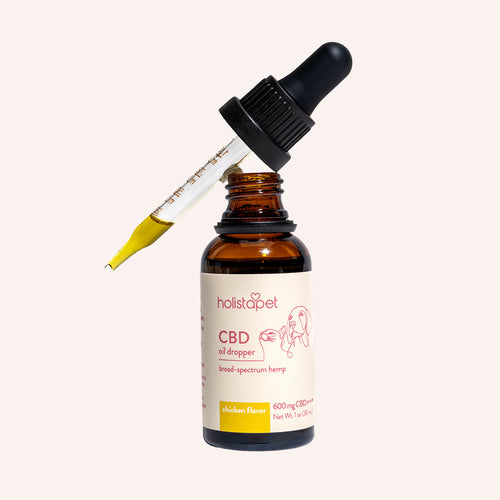 Chicken Flavored CBD Oil For Dogs - Easy Dose
Chicken Flavored CBD Oil For Dogs - Easy Dose
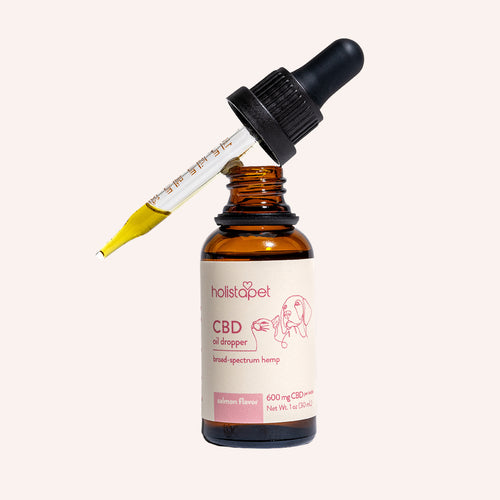 Salmon Flavored CBD Oil For Dogs - Highly Rated
Salmon Flavored CBD Oil For Dogs - Highly Rated
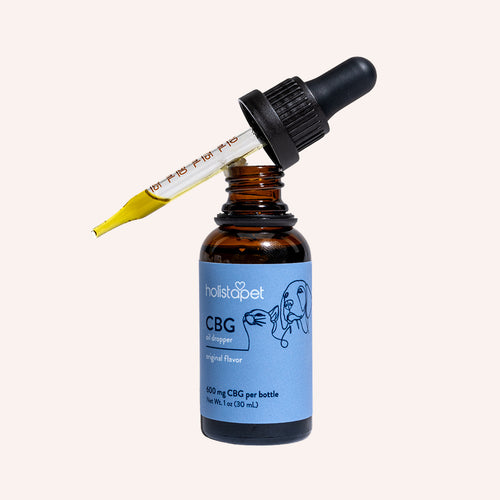 CBG Oil for Dogs and Cats - Loved by Thousands
CBG Oil for Dogs and Cats - Loved by Thousands







Leave a comment
All comments are moderated before being published.
This site is protected by hCaptcha and the hCaptcha Privacy Policy and Terms of Service apply.